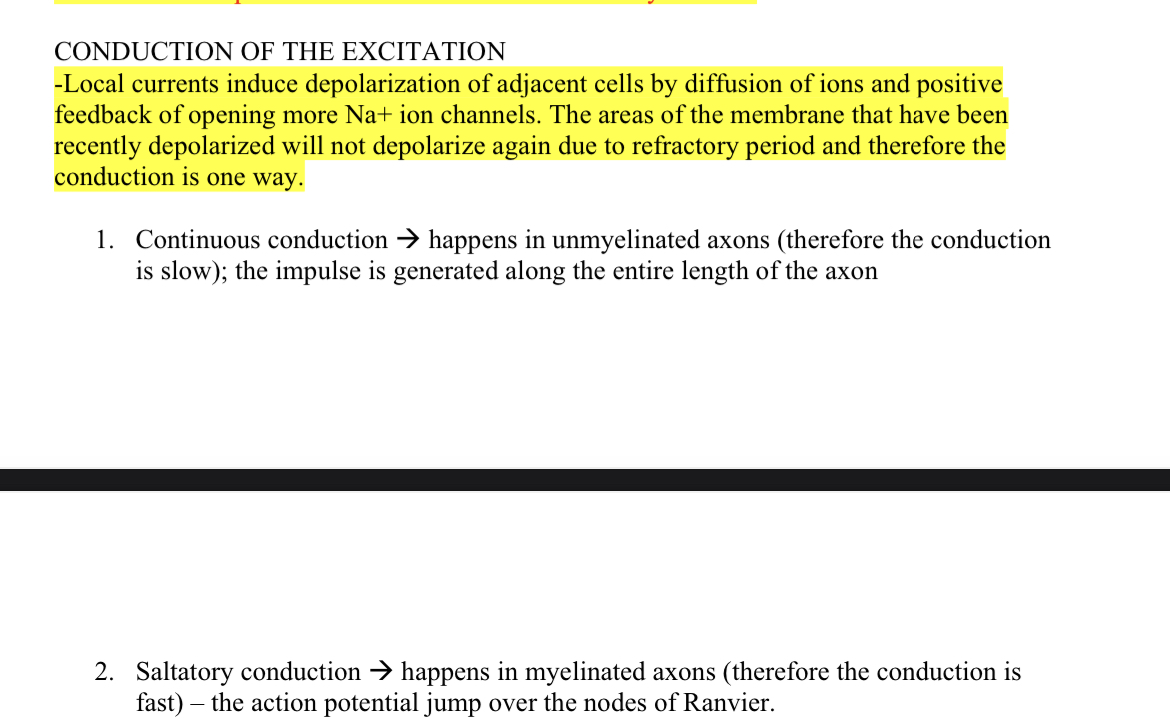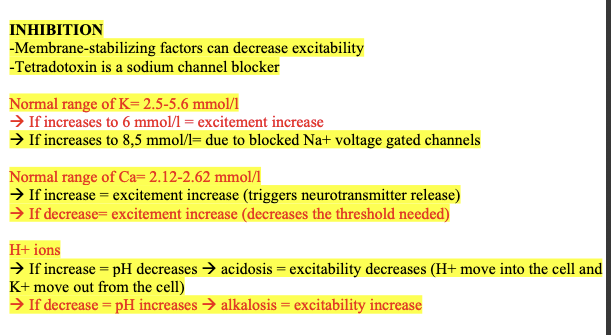essay 3 - Physiology of the excitable cells. Irritability and Excitability. General and specific properties of the excitable cells. Membrane potential – ionic basis of the membrane potentials. Measurement of excitability. Changes in the excitability during excitation. Inhibition. Conduction of the excitation
1/10
There's no tags or description
Looks like no tags are added yet.
Name | Mastery | Learn | Test | Matching | Spaced |
|---|
No study sessions yet.
11 Terms
irritability
IRRITABILITY
=The ability of the cell to react to stimuli from external or internal environment by increase or decrease of its activity.
Irritants differ in:
-Intensity of stimulus
-Duration
-Gradient of increaseàslowly rising irritants fail to fire the nerve because nerve adapts to applied stimulus
-
excitability
EXCITABILITY
=Response of the cell to the change of the environment (irritation) by changing the membrane potential. They are able to generate and transmit an action potential in cases where the stimulus is strong enough (reaches the threshold)
Excitable tissues include:
-Motor neurone →longest to cause action potential
-Skeletal muscle→fastest to cause action potential (contraction of muscle cells)
-Heart muscle (contraction of muscle cells)
-Endocrine cells (produces and release hormones)
excitable tissues and nervous tissue
Neurons- communicate
• respond to stimuli
• Extending out from the cell body are processes called dendrites and axons.
• -conduct impulses (with dendrites conducting impulses toward the cell body
• axons conducting impulses away from the cell body
• Neurons can respond to stimuli and conduct impulses because a membrane potential is established across the cell membrane.
• Membranes have a RESTING MEMBRANE POTENTIAL. - an unequal distribution of ions (atoms with a positive or negative charge) on
the two sides of the nerve cell membrane.
• This POTENTIAL about -70 mV (with the INSIDE of the membrane negative )

resting membrane potential depends on
in a resting membrane there is

action potential generation
1. Resting State
Membrane potential is about -70 mV.
Maintained by the Na⁺/K⁺ pump:
→ 3 Na⁺ out, 2 K⁺ in (net loss of positive charge inside).This uneven ion distribution creates a negative membrane potential.
The membrane is more permeable to K⁺, further maintaining negativity inside.
⚡ 2. Depolarization (Stimulus Applied)
A stimulus causes some voltage-gated Na⁺ channels to open.
Na⁺ ions rush in, making the inside more positive.
If the membrane potential reaches threshold (~ -55 mV) → this triggers the action potential.
This is where the action potential is generated — a rapid, all-or-nothing depolarization.
⚡ 3. Action Potential Peak
Massive influx of Na⁺ continues as more Na⁺ channels open (positive feedback).
Membrane potential rises sharply to around +30 mV.
This is the peak of the action potential.
⚡ 4. Repolarization
Na⁺ channels inactivate (they close).
Voltage-gated K⁺ channels open, allowing K⁺ to flow out.
Loss of positive charge causes the membrane potential to drop (becomes more negative again).
⚡ 5. Hyperpolarization (Undershoot)
K⁺ channels remain open longer than needed, causing excess K⁺ to exit.
Membrane potential dips below -70 mV, sometimes to ~ -80 mV.
This is the refractory period — the neuron is less excitable.
🔄 Return to Resting Membrane Potential
K⁺ channels finally close.
Na⁺/K⁺ pump and leak channels restore the membrane to -70 mV.
measure of excitability
2. Rheobase
The smallest current (stimulus strength) that can trigger an action potential if applied for a long time.
It's like the "minimum power level" needed to fire a cell.
Low rheobase = highly excitable
High rheobase = less excitable
3. Chronaxie
The minimum time required for a current twice the rheobase to trigger an action potential.
Tells you how quickly a cell responds to a strong stimulus.
Lower chronaxie = faster response = more excitable
Threshold Potential
This is the minimum membrane potential needed to trigger an action potential.
More negative threshold = less excitable.
Closer to RMP = more excitable.
changes in excitability
Sure! Here's a more concise and clear version of your notes on the refractory periods:
---
### 🔄 Refractory Periods (Simplified)
1. Absolute Refractory Period
→ No response possible, no matter the stimulus.
→ Na⁺ channels are inactivated.
2. Relative Refractory Period
→ Very strong (suprathreshold) stimulus needed.
→ Some Na⁺ channels recovering, K⁺ still flowing out.
3. Supernormal Period
→ Cell is more excitable than normal.
→ Occurs just after repolarization, near resting potential.
4. Subnormal Period
→ Cell is less excitable than normal.
→ Occurs during late hyperpolarization. super threshold stimulus needed
ARSS
conduction of excitation

INHIBITION
-Membrane-stabilizing factors can decrease excitability
-Tetradotoxin is a sodium channel blocker
Normal range of Ca= 2.12-2.62 mmol/l
àIf increase = excitement increase (triggers neurotransmitter release)
àIf decrease= excitement increase (decreases the threshold needed)
H+ ions
àIf increase = pH decreasesàacidosis = excitability decreases (H+ move into the cell and
K+ move out from the cell)
àIf decrease = pH increasesàalkalosis = excitability increase
inhibition
INHIBITION
-Membrane-stabilizing factors can decrease excitability
-Tetradotoxin is a sodium channel blocker
Normal range of Ca= 2.12-2.62 mmol/l
àIf increase = excitement increase (triggers neurotransmitter release)
àIf decrease= excitement increase (decreases the threshold needed)
H+ ions
àIf increase = pH decreasesàacidosis = excitability decreases (H+ move into the cell and
K+ move out from the cell)
àIf decrease = pH increasesàalkalosis = excitability increase
